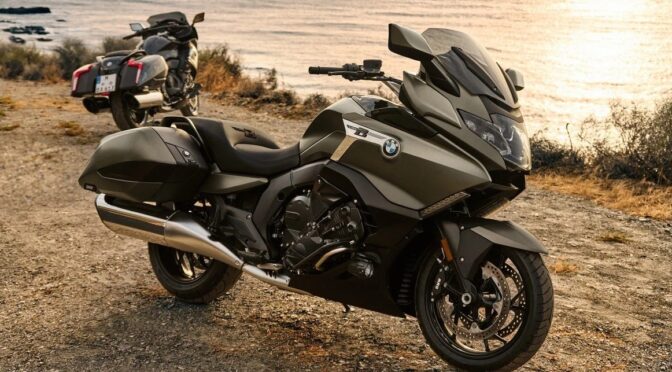Check-out our Motorcycle Tours!
Dr. Jekyll & Mr. Hyde
Intro
The term bagger comes from America and identifies that kind of travel motorcycle characterized by fixed panniers, a tapered downwards rear part, and a wide fairing with a low windshield, of which the Harley-Davidson Road Glide is perhaps the most typical example.
The K1600B (the “B” stands for “bagger”) presented at the end of 2017 is an example of how BMW moves when it approaches a genre that is traditionally not its own: It identifies the typical elements — those listed above — but then creates an absolutely different object from the norm and equipped with a decidedly BMW mechanical and technical scheme in general.
In the past, this same operating philosophy had inspired the creation of the splendid R1200C cruiser series, based on the traditional boxer twin. In our case, instead, the choice surprisingly fell on the 1649 cc 6-cylinder of the K Series which, displacement aside, is the furthest you can imagine from the American V-Twin in terms of design and operating characteristics.
The result of this operation is certainly an unconventional object, but apparently it has not completely satisfied BMW’s desire to expand in this sector, given that in 2020 it also launched the R18B with mechanics based on the new and gigantic 1802 cc Big Boxer twin-cylinder, much closer to American philosophy, and decidedly more classic in shape.
The bike tested is a Model Year 2023. Some improvements have been introduced starting from MY 2022, such as the TFT instrumentation and, above all, the Euro-5-compliant version of the inline 6 engine.
The K1600s were born in 2010 with a Euro 3 engine and that’s exactly the version I tested in 2013. I’ve heard someone complaining about the next Euro 4 series, released in 2016, which allegedly seems to have lost some edge under acceleration, so I’m curious to see how the current Euro 5 engine behaves. By the way, its technical data sheet shows significantly better data than those of the previous series, identical on paper.
The K1600B shares its entire mechanics with the other K1600s, except for slight variations relating to the suspensions, so all the considerations that will be made below are valid for any Euro 5 K, unless otherwise specified.
How It Is
Appearance
The line of the K1600B certainly has a different personality from that of the classic GT and GTL but, in my opinion, it is not completely convincing in terms of consistency. The front view is the usual one: modern, imposing, and efficient, only with a shorter windshield; while the entire rear part, obviously tapered downwards as the genre requires—with its integrated bags with a tapered design, the retro-style tail, the two large exhausts cut into a slice of salami, and the perimeter rear lights with a very refined design—is marked by a simpering elegance which, in my opinion, does not harmonize perfectly with the front part.
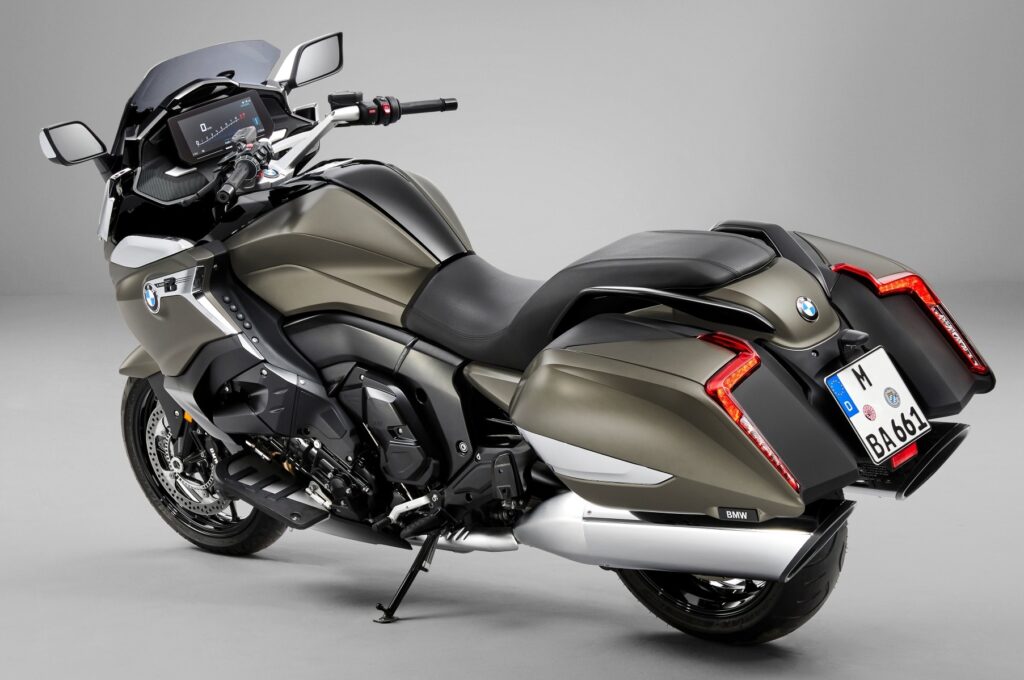
The side bags, with a more streamlined design compared to that of the other K1600GT and GTL, are fixed and this fact has made it necessary to make the rear mudguard removable, to allow the replacement of the wheel.
Compared to the traditional Ks, some things have changed: the seats, particularly the passenger seat which is flat and wider than usual; the lower part of the fairing, which is less extensive and also leaves the gearbox-clutch group in sight along with the engine; and the black, tubular handlebar, which can be replaced on request by a more classic aluminum handlebar, similar to the one on the GTL.

Chassis
The chassis is based on a sturdy double beam and open cradle frame in light alloy, conceptually similar—but certainly more beautiful to look at—than that of the 4-cylinder Ks. The engine is anchored below it, which limits the distance between the beams and therefore the overall width of the motorcycle. The engine protrudes laterally with respect to the frame and is left in full view by special openings in the side panels.
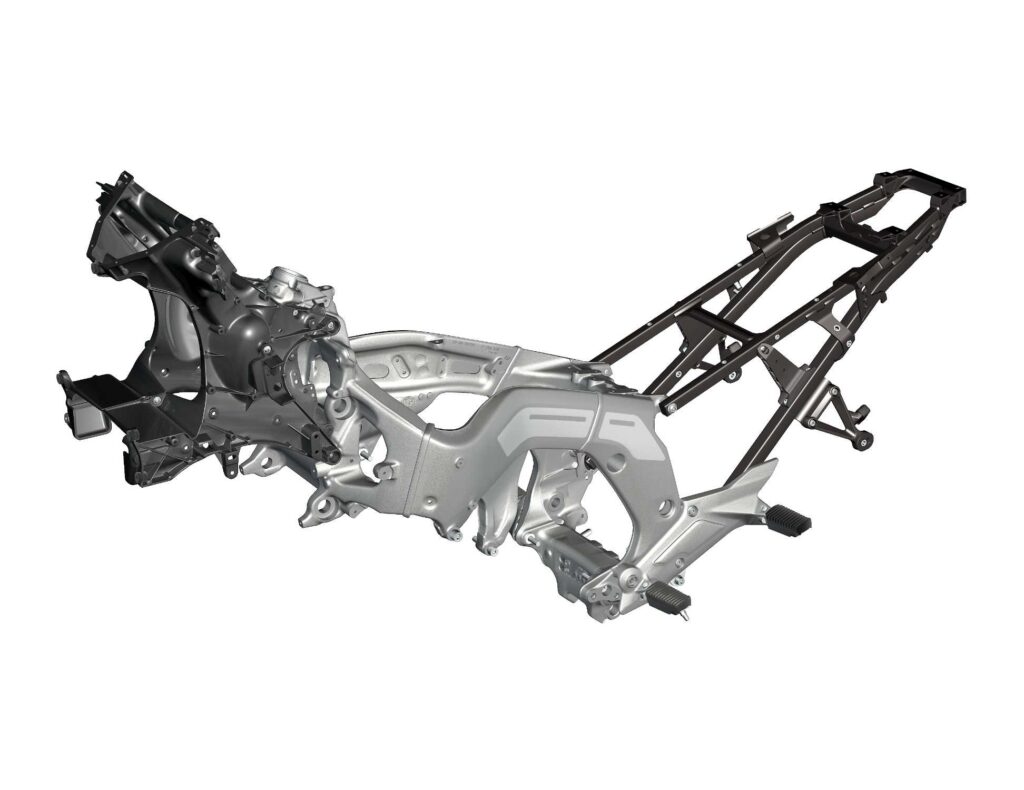
At the front, a bolted magnesium box supports the upper section of the fairing, the light unit, the dashboard, and the mirrors; while behind, there is an extruded aluminum frame, which on the K1600B and Grand America is shorter than the one present on the GT and GTL and includes specific tubulars to support the fixed side bags.
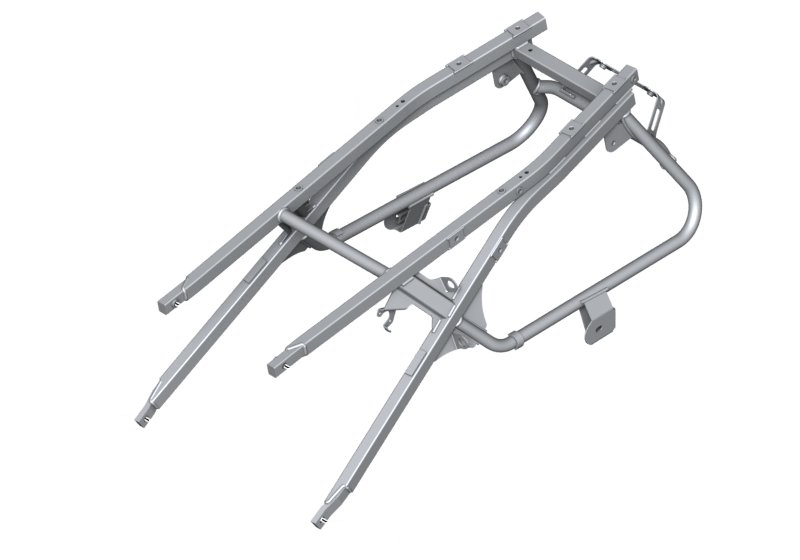
The chassis is completed by the classic BMW Paralever rear suspension and the Duolever front suspension.
The Paralever suspension consists of a hollow die-cast aluminum single swingarm, hinged at the front to the frame and at the rear to the unit containing the bevel gear and the wheel axle, and by a boxed bar parallel to the swingarm which also connects the frame to the rear unit. The transmission shaft is housed in the swingarm with two cardan joints, while the shock-absorbing function is entrusted to a central monoshock. This configuration controls the reactions induced by the cardan shaft on the suspension during acceleration and deceleration—the old transmission caused the suspension to fully extend under acceleration and sink completely under braking—and it is calibrated not to eliminate them completely, in order to ensure an anti-squat effect in acceleration similar to that caused by the chain in motorcycles with traditional transmission. Very interesting and inherited from the K1200/1300 is the fact that the shock absorber is mounted on a progressive damping linkage similar to the Honda Pro-Link system.
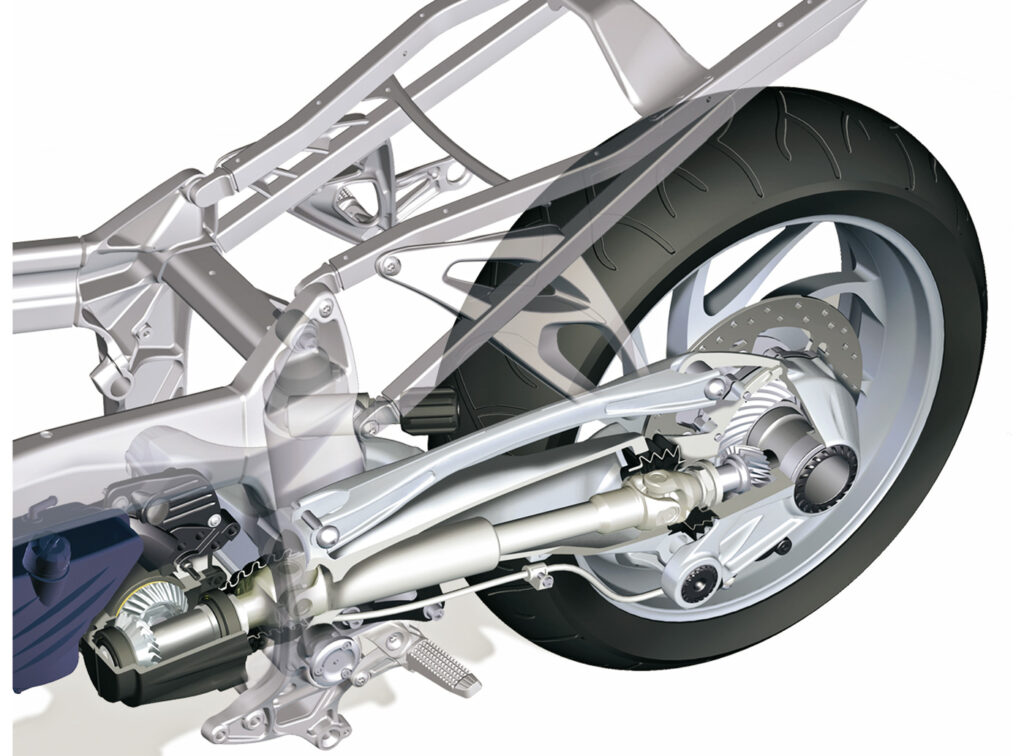
Paralever suspension of the K1600, the progressive linkage triangle is partially visible behind the footpeg
The Duolever suspension—commercial name adopted by BMW for the Hossack fork—consists of an inverted U-shaped element in die-cast aluminum which supports the wheel, connected by ball joints to two forged steel triangular wishbones hinged to the frame. There are therefore no triple clamp nor struts and the shock absorbing function is ensured by a monoshock that connects the frame with the lower wishbone. Steering takes place by means of two triangular connecting rods hinged to each other, connected below to the fork and above to a short steering tube on which the handlebar is mounted. This particular construction ensures interesting advantages compared to a traditional fork:
- a much higher torsional rigidity, which gives impressive driving precision, especially at high speeds.
- when the suspension swings, the wheel well moves almost vertically, rather than moving diagonally and parallel to the steering axis, and this has two effects:
- the wheelbase remains almost unchanged as the suspension swings, ensuring superb stability under braking
- lacking the horizontal component in the movement of the wheel, the front end of the bike dives much less than usual under braking
- as a result of the reduced squatting, it is possible to adopt a significantly softer shock absorber than usual, with clear advantages on uneven surfaces.
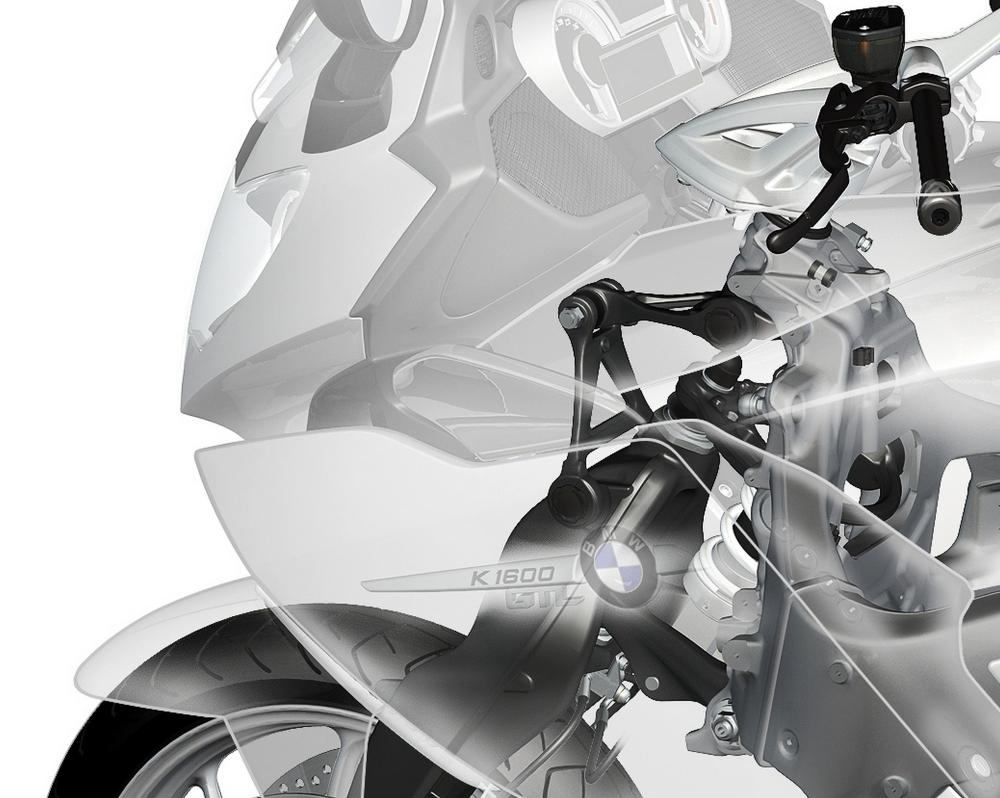
The main dimensions are as follows.
- front wheel travel 115 mm
- rear wheel travel 125 mm
- wheelbase 1618 mm
- trail 106.4 mm
- rake 27.8°
The only difference in the dimensions with the K6 GT and GTL is given by the rear wheel travel reduced by 10 mm, consistent with the visual lowering of the rear axle.
Some consideration must be made for the steering axis angle. For geometric reasons, the closer the axis is to the vertical, the more quickly the wheel steers with the same handlebar rotation angle – making the bike more maneuverable, but also more nervous at high speeds – and the less the fork dives in violent braking. Super sports bikes always have a rather small angle—the S1000RR, for example, sports an almost brutal 23.8°—to favor handling and set-up under braking, while fast touring bikes adopt a slightly more relaxed angle—25.5° on the S1000XR and 25.9° on the R1250RT —looking for more stability.
The Ks equipped with Duolever wishbone suspension are a conspicuous exception to this rule, as they have always had a very wide angle, partly to favor the stability at the high speeds of which they are capable, but above all because the particular kinematics of their suspension front considerably reduces the diving under braking and therefore allows you not to have any particular hesitations in this regard. Suffice it to say that the K1300S sport tourer, capable of over 275 km/h, has a steering angle of 29.6°, similar to that of a Harley-Davidson Sportster 883 (!).
Seen in this context, the 27.8° angle adopted on all K1600s is quite sporty. The current Honda Gold Wing, completely comparable to the Ks including the wishbone front suspension, sports a much more touristic 30.5° angle.
The trail, on the other hand, directly affects the heaviness of the steering, because the longer it is, the more the front end moves towards the inside of the curve when you steer, opposing greater resistance. Obviously, the weight on the front end also affects this characteristic. It therefore appears clear that the reduction of the trail from 115 mm of the K1300GT to 106.4 mm of the K1600 was decided to favor handling in consideration of the greater weight on the front wheel. It is no coincidence that the prescribed pressure on 6-cylinder models is 2.9 bar on both axles, against the canonical 2.5 front and 2.9 rear of the K1300.
The wheels are made of alloy—a beautiful Classic forged rims set is available on request—with tubeless tires, in the usual sizes 120/70 ZR 17 on a 3.5 x 17″ rim at the front and 190/55 ZR 17 on a 6 x 17″ rim at the rear.
Engine
Thirteen years after it was first marketed, the 1649 cm3 in-line six-cylinder with DOHC 24-valve distribution and bank inclined forward by 55°—like the K1300 four-cylinder—is still a great piece of engineering, which ensures BMW an imperishable place in the Olympus of Gran Tourismo motorcycles alongside the equally sensational boxer of the Honda Gold Wing 1800.
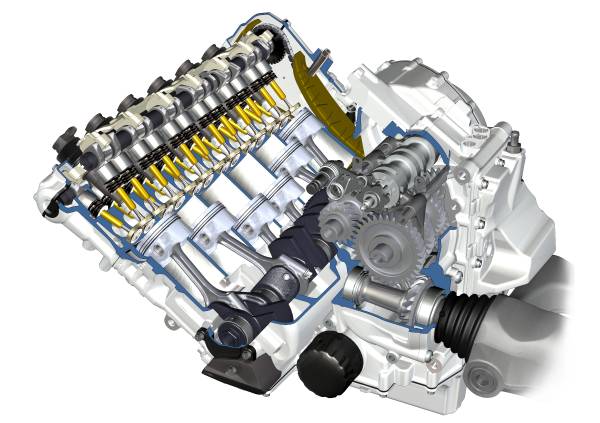
As is well known, this cylinder configuration ensures the almost total absence of vibrations—therefore there is no need to adopt balance shafts—and fantastic smoothness of operation especially at very low revs; however, this is at the price of a rather heavy weight and a considerable width, normally about 20-25% higher than the already important one of a 4 in-line with the same engine capacity.
To contain the transversal dimension, the BMW engineers opted for an engine with a relatively long stroke (67.5 mm) in order to limit the bore (72 mm) and therefore obtain a narrower block. Even more interesting in this regard are the reduction of the distance between the cylinders, limited to only 5 mm against the approximately 10 mm generally in use, and the positioning of the electrical accessories next to the cylinder block and not at the ends of the crankshaft as usual. All these features make it possible to limit the total width of the engine to just 56 cm. For comparison, the 1301 cc in-line 4 of the BMW K1300 measures 50 cm. If we imagine pantographing it up to the 1649 cc of the 6-cylinder, the measurement would rise to 54.1 cm, so we can say that BMW has managed, all other things being equal, to contain the increase in width to a sensational 3.5%. Equally significant is the comparison with the inline 6 of the 1979 Kawasaki Z1300, which despite “only” 1286 cc, is 63.5 cm wide, a good result for the time, but still 27% more than the BMW 4 cylinders of similar volume.
Although limited in the maximum power possible by these choices, the BMW 6-cylinder is still capable of 160 HP, more than abundant for a touring bike which, moreover in this new Euro 5 version, is delivered at just 6,750 rpm against the 7,750 claimed of previous releases. Torque is even more interesting, with a maximum peak of 180 Nm at 5,750 rpm, 5 Nm more than in the Euro 3 and 4 versions. The work done by BMW engineers in adapting this engine to the strictest anti-pollution regulations is truly impressive.
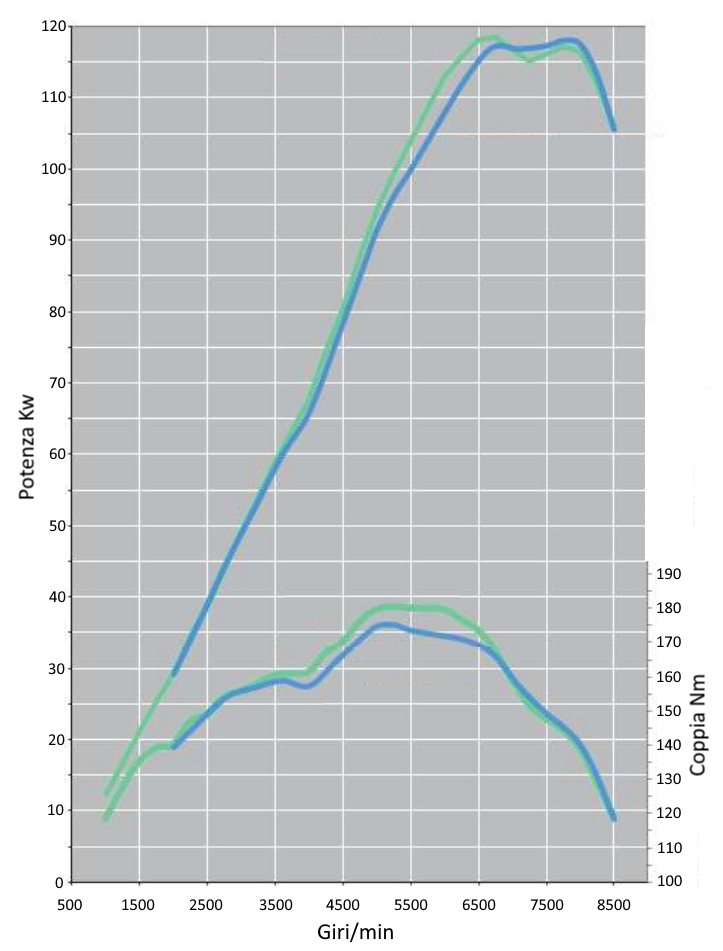
The graph, taken from the BMW press kit of the K1600 MY 2022, shows, in addition to the fact that there are almost 120 Nm at 1,000 rpm (!), a significant increase in maximum torque between 3,000 and 7,000 rpm in favor of the Euro 5 version (light blue) compared to Euro 4 (blue), with a corresponding decrease in maximum power.
As far as weight is concerned, the scale reaches 102.6 kg, which is decidedly low for a 6-cylinder of this engine capacity, but a lot compared to the 81 kg of the 4-cylinder 1300 which delivers the same maximum power. Not surprisingly, the K1600GT first series weighed 319 kg against the 288 of the K1300GT with the same equipment.
Transmission
The gearbox of the K6 is characterized by the construction on three shafts — usually two are used — to reduce its width in the footpegs area.
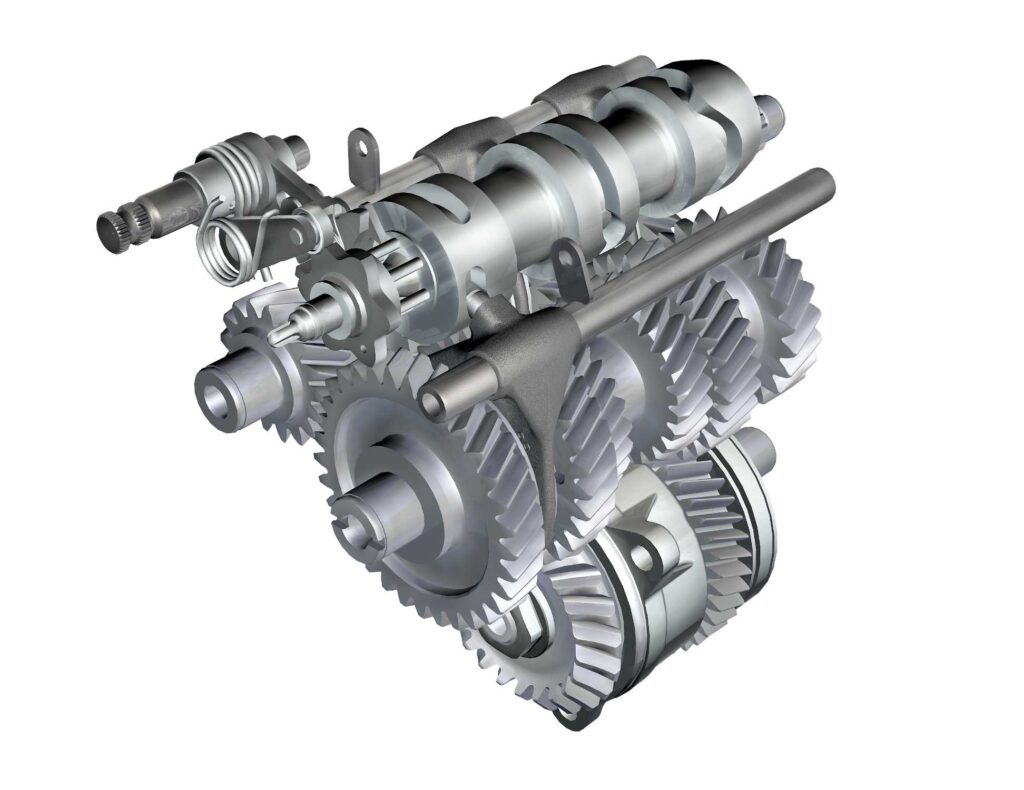
2nd and 3rd gears are relatively close to each other and so are 5th and 6th. The ratios are quite long, with the 6th gear allowing you to travel at 130 km/h at around 3800 rpm, a decidedly restful regime.
The slipper clutch is hydraulically actuated and with a special power assistance mechanism. The Shift Assistant Pro, i.e., the BMW quickshifter with auto-blipper, is available on request.
The transmission ratios, the same for all present and past K1600s, are as follows:
| Gear | Ratio |
|---|---|
| Primary | 1.617 |
| 1st | 2.230 |
| 2nd | 1.641 |
| 3rd | 1.319 |
| 4th | 1.101 |
| 5th | 0.926 |
| 6th | 0.788 |
| Final | 2.750 |
The resulting speeds at the most significant rpms are as follows:
| Gear | Speed @ real torque start (5,000 rpm) | Speed @ peak power (6.750 giri) | Speed @ rev limiter (8.500 giri) |
|---|---|---|---|
| 1a | 60,9 | 82,2 | 103,5 |
| 2a | 82,7 | 111,7 | 140,7 |
| 3a | 103,0 | 139,0 | 175,0 |
| 4a | 123,4 | 166,5 | (teorica) 209,7 |
| 5a | 146,7 | 198,0 | (teorica) 249,3 |
| 6a | 172,4 | (teorica) 232,7 | (teorica) 293,0 |
The final drive is, in BMW tradition, a shaft with two cardan joints.
Brakes
The K1600GT is equipped with two 320 mm front rotors with traditional-style Brembo four-piston fixed calipers, while at the rear there is also a large 320 mm rotor with two-piston floating caliper. All brakes are actuated by traditional pumps through steel braided hoses.
The ABS system is of the semi-integral type, with the lever operating both brakes and the pedal acting only on the rear. As always in BMW, the two braking circuits are independent; the integral function is obtained via the ABS pump and is therefore active when the ignition is on.
Advanced Driver Assistance Systems (ADAS)
From the point of view of electronic driving aids, the K1600B is obviously equipped with a 6-axis inertial platform and offers practically everything as standard.
- ABS Pro – Anti-lock braking system with rear wheel lift control and cornering function, which reduces the initial braking power at the front when the bike is leaning and serves to minimize the effects of too abrupt actuation of the front brake when cornering.
- DTC (Dynamic Traction Control) – Disengageable anti-slip system that takes into account the lean angle of the bike.
- Three riding modes – Rain, Road and Dynamic.
- MSR (“Motor Schleppmoment Regelung”, i.e., engine brake regulation) – System that automatically regulates engine braking, decreasing it (i.e., accelerating) in the event of sudden downshifts, so as to avoid any rear wheel skidding.
- Dynamic ESA (Electronic Suspension Adjustment) – Self-adaptive suspension system, which acts by automatically adjusting the hydraulic suspension damping according to driving and road conditions, automatically adjusts the preload according to the weight on board and allows you to choose two basic settings: a comfortable Road, and a stiffer Cruise. Note that on the K1600B, the possibility of lowering the height to a minimum, present on other models, is absent: Given the lower seat, it would not make much sense.
- HSC Pro (Hill Start Control) – System that allows you to automatically keep the bike on the brakes when it’s stationary, with the advantage of having your hands free with both feet on the ground and simplifying hill starts. The system can be set to be activated manually by forcefully pulling the brake lever, or to be activated automatically if you keep the brakes pulled with the motorcycle stationary on a slope for at least one second.
- RDC (tire pressure control) – System which shows the tire pressure on the display and warns in the event of a loss of pressure.
The DBC (Dynamic Brake Control) system, that shuts the throttle during brakings, present on other BMW models, is absent on the K1600s. It was probably assumed that a beginner, to whom is typically given such help, would never drive such a monster.
The choice of riding modes affects the behavior of the throttle, the DTC, and the anti-wheelie function to harmonize them with each other in the various situations, while the two settings for the Road and Cruise suspensions can always be selected in all riding modes. Below are the configurations foreseen in the various cases.
Rain:
- smooth throttle response
- DTC adjusted for maximum stability on a wet road, it leads to a reduction in maximum acceleration on a dry road surface
- anti-wheelie to the max.
Road:
- normal throttle response
- DTC adjusted for high stability on a dry road with delayed intervention compared to Rain mode
- anti-wheelie to the max.
Dynamic:
- direct throttle response
- DTC adjusted for high performance on dry surfaces with delayed intervention compared to Road mode. in the event of a poorly maintained surface, it is impossible to guarantee optimal stability.
- anti-wheelie that allows a slight lift of the front.
Accessories
Standard
In addition to what is indicated above, the following accessories are standard:
- 10.25-inch TFT instrument cluster with connectivity option and integrated map navigation via the BMW Motorrad Connected app
- full LED lighting with adaptive headlight
- electric reverse assist
- cruise control
- heated grips
- pilot and passenger seats separately heated
- Intelligent Emergency Call system
- side bags
- storage compartment with USB-C plug
- electrically adjustable low windscreen
- manually retractable flaps for dynamic ventilation
- bi-tonal horns.
Optional
The options available from the factory (in Italy, please check by your local dealer) are the following:
- Comfort Package:
- Keyless Ride
- centralized locking of the trunks and compartments
- quickshifter with auto-blipper
- anti-theft alarm system (DWA)
- Tour Package:
- Audio 2.0 radio system with front speakers and navigation predisposition
- additional LED headlights
- paramotor
- forward platform footrests
- storage compartments
- ground lighting
- high seat (no extra charge)
- Option 719 seat
- Classic Option 719 forged wheels
- forged aluminum handlebar
- central stand
- short tinted windshield
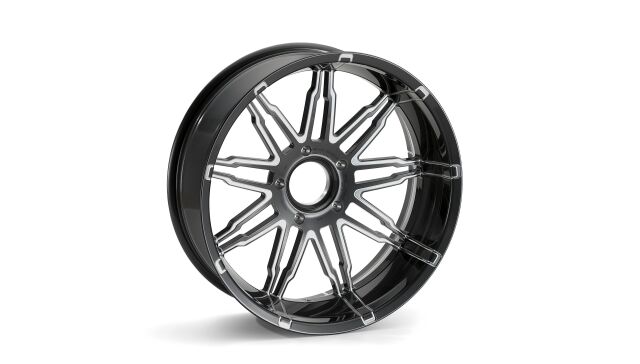
Four types of bags to be mounted on the passenger seat, various chrome details, and a set of inner bags for the side cases are also available in the aftermarket.
Controls
The controls are the classic ones of the current BMWs, but with some differences compared to the other models due to the different on-board equipment. There are so many, especially on the left side, that the lack of a backlight is felt at night. Furthermore, the different functions attributed to some keys creates obvious complications in some cases, which we will see later.
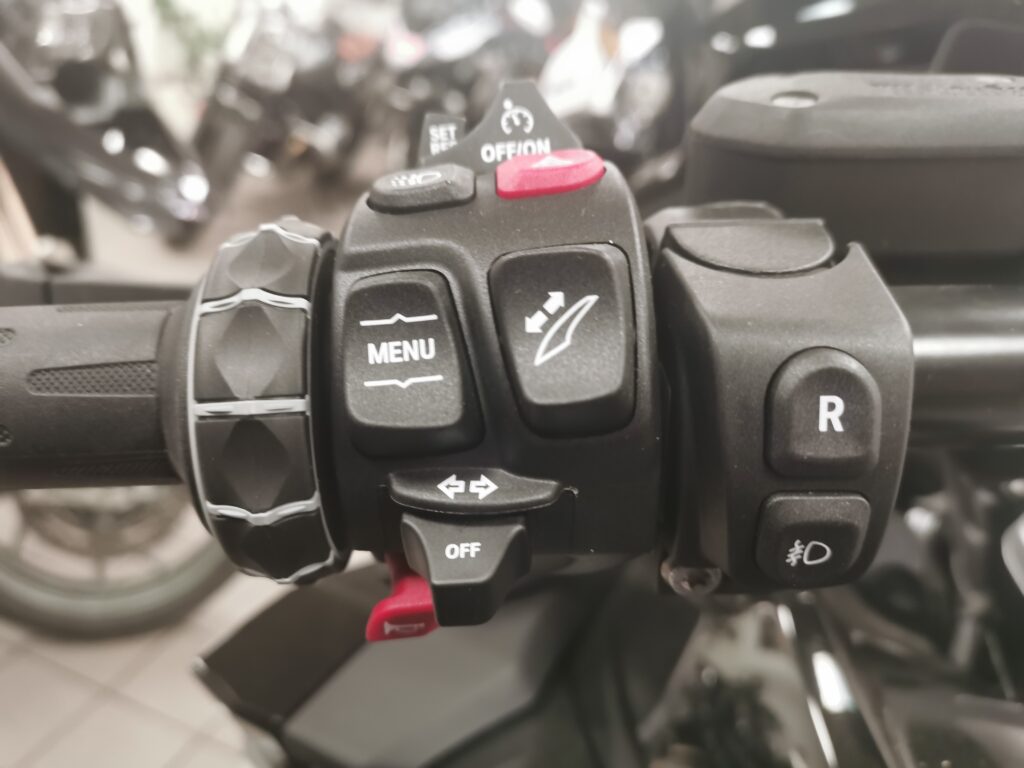
The turning lights shut off automatically, which however can curiously be deactivated through the Settings menu. Their duration depends on the driving situation. I haven’t tried all the situations in detail, nor does the user manual contain an exhaustive explanation of how they work, but while driving, I’ve never found myself needing to restart a blinker that lasted too short a time. If the left indicator is switched on when the ignition has just been switched off, the parking lights turn on and are shut off automatically the next time the ignition is switched on.
The horn button is exactly where it should be and activates a two-tone system that will bring the surrounding traffic to a halt in surprise, hurray!
The high beam flashing is obtained by pressing with the index finger a lever located above the left block, while the light switch is activated by pushing the same lever outwards.
The left block also houses:
- the Multi-Controller, i.e., the wheel to navigate and select the different options on the screen
- the Menu rocker switch to scroll through the different TFT dashboard views and menus
- the rocker button for electric windshield adjustment, which takes the place of the usual button for disengaging the DTC and selecting the D-ESA suspension mode
- The red button for the hazard warning
- The controls of the BMW cruise control, which is standard.
As usual, this is operated by a lever equipped with a sliding guard that acts as an on-off switch. Once the guard has been moved to the right, pushing the lever forward sets the current speed, which is maintained until you brake or pull the clutch or shift (but not if you upshift using the optional quickshifter) or force gas shut off. If, with regulation active, the lever is briefly pressed forwards or backwards, the speed increases or decreases by one km/h at a time—or by one mph, based on how the unit of measurement is set in the Settings menu. If you hold it down instead, the set speed increases or decreases in steps of 10 km/h—or 5 mph—and the motorbike accelerates or decelerates progressively until you release the command; while when the adjustment is deactivated, pulling the lever all the way back, the last stored speed is recalled.
In a supplementary element placed next to the left block there are:
- The R button to engage the electric reverse assist
- The button for switching on the anti-fog lights.
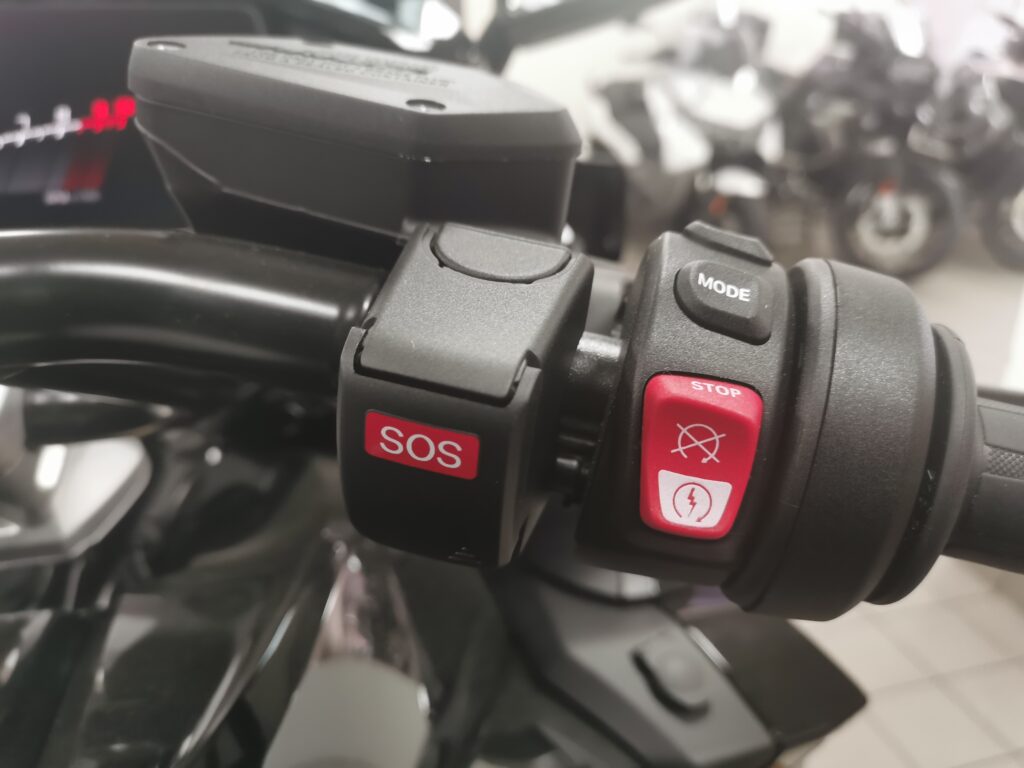
On the right block there are instead:
- The optional central locking button, which replaces the heated grip control
- The riding mode selection button
- The rocker switch for engine start and kill.
The central locking controls the side cases and, if fitted, the additional storage compartments. In any case, each suitcase and each compartment is also equipped with a key lock which, if blocked, prevents opening with the centralized locking.
The start button is also used to engage reverse assist. The electric reverse is activated by keeping it pressed after pressing the R button on the left block with the engine running in neutral and the brake is pulled. The engine idle rises automatically to compensate for the high electrical absorption and moves the bike with good progression and at an easily controllable speed.
In an additional element located next to the right block, under a cover clearly highlighted by the SOS sign, the key of the Intelligent Emergency Call system is housed as standard for obtaining help in emergency situations. The system uses its own SIM and therefore does not require the possession of a smartphone. When the button is pressed, or automatically if the system detects an accident, the system calls the BMW Call Center, which addresses the rider in his language via a loudspeaker and microphone installed on the bike, and activates the rescue chain as needed .
The different function assigned to some buttons entails the drawback that, to manage many functions—D-ESA suspensions, heated grips and front seat, radio, and others—it is necessary to access the relative settings in the vast Settings menu. It might seem only a minor detail, but often it gets really annoying. For example, to turn the heated grips on to maximum, an operation that usually requires pressing a dedicated key on the K1600 and on the R1250RT, you must first press the Menu key several times (depending on the screen you are in) to reach the Settings menu, after which you must perform five distinct operations with the big wheel, each comprising one or more pulses:
- down to Heating
- right to enter Heating
- down to Knob heating
- right to enter Knob heating
- up to select the intensity from 0 to 5.
And then you have to go back to the home screen, of course. All this stuff requires an expenditure of time and mental energy disproportionate to the required action. In addition, it must be repeated every time you want to adjust the temperature or turn off the heating. I understand how the complexity of the equipment requires an effort to simplify the controls, but here it borders on sadism.
In an attempt to remedy this problem, BMW has inserted four customizable buttons in the left fairing on the Euro 5 version, each of which can be assigned a specific function. The intent is commendable, but on the one hand this forces the user to do a programming job that not everyone wants to do—always assuming they read the user manual; on the other hand, the keys are in an awkward position; and, in any case, you have to remember which key is dedicated to what or consult the menu to get the list. In my opinion, it would be much more logical to reassign to the central locking button—whose function is already performed by the key!—the control of the heated grips, which is the command that is used the most, and add a couple of keys above the reverse gear and emergency call blocks.
The Keyless Ride system is also available on request. The key remains in your pocket, while the ignition and steering lock are governed by a key in place of the ignition lock. When the key is near the motorcycle, pressing the button briefly turns the ignition on, pressing it again briefly turns it off, while holding it down for a couple of seconds also engages or disengages the steering lock. The system also acts on the tank cap, which can be opened only when the ignition is off and within a couple of minutes of switching it off. Among the various systems of this kind that I have tried, this is undoubtedly the best, yet I still prefer the traditional key system, which is faster to operate, is practically indestructible and—above all—allows the user to always keep the key under control. If contact with the key is lost with the engine running, it does not switch off, for obvious safety reasons, but the warning appears on the dashboard that the key is no longer nearby and that it is no longer possible to restart the engine. The warning is pretty big, but it can happen that you don’t pay attention to it, especially just after a start. As long as the rider is still the same and keeps the key in a secure pocket, all is well; but any variation from the norm—key dropping from a trouser pocket or forgotten in the passenger’s jacket after dropping him/her off at home, motorcycle lent by a friend, etc.—it can mean wasting time to retrieve the key or, worse, being stranded at the first stop.
Dashboard
The dashboard consists of a huge 10.25″ display, exclusive to the K1600 and R1250RT, housed as usual in a frame containing the various basic warning lights: direction indicators, main beam, daytime running lights, fog lights, generic warning triangle, ABS, DTC, and engine failure.
The large width of the display offers the possibility of splitting the screen in two, with the selected view narrowing to make room for a smaller supplementary display on the right-hand side, which can be one of the two available Trip Computers or Navigation or Media. This feature eliminates the only real defect of standard BMW TFT instruments, i.e., the impossibility of simultaneously seeing more than one piece of information from the on-board computer together with the speedometer and tachometer.
The Pure Ride display is the standard one and includes a large tachometer bar, the red sector of which is larger with a cold engine and narrows as the temperature rises, digital speedometer, speed limit indicator (with smartphone connection), cruise control activation indicator with set speed, gear engaged indicator, current riding mode, digital clock, ambient temperature, range remaining, and just one of the data on the My Vehicle or Trip Computer screens—fuel level, trip mileage, average consumption, etc.—and numerous secondary spies. [?secondary spies?]
The Menu display instead allows you to select one of the following menus:
- My vehicle – information system including several switchable tabs:
- My vehicle displays total mileage, coolant temperature, tire pressure, on-board power supply voltage, range, and service interval indicator
- Trip computer – – hows average speed, average fuel consumption, total trip time, total stop time, partial and total mileage, last reset date.
- Trip computer – it is the same as the previous one; it allows you to collect data on a different section and it resets itself after six hours of stop or when the date changes
- Tire inflation pressure – in addition to the pressure compensated with the operating temperature visible in the My vehicle tab, it also shows the actual tire pressure
- Maintenance Needed – Indicates the expiration date and remaining mileage until the next maintenance
- any additional tabs containing the check control messages
- Radio – Manages the on-board digital radio, which can be listened to through the on-board speakers—even with automatic volume adjustment based on speed—or in the helmet hands-free system
- Media – Works if a compatible device and a helmet with a compatible hands-free system are connected and allows you to listen to the music on the device
- Navigation – Works with a smartphone using the BMW Motorrad Connected app; allows control of navigation functions and display of either a smartphone GPS-operated map or a simplified display with arrows and text
- Phone – Works when a compatible device and a helmet with a compatible hands-free system are connected and allows you to make and receive phone calls.
Lighting
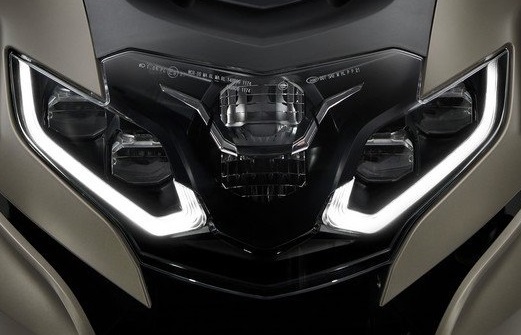
The K1600B has a particularly sophisticated and decidedly unique full-LED lighting system as standard. A single large optical assembly includes two pairs of high-beam headlights on the sides, each edged below by the slim profile of the daytime/running lights. The center is occupied by a pair of low-beam headlights connected to the inertial platform that governs the bike electronics. This allows the low-beam headlights to follow any curve of the road, compensating for any pitching and rolling movement of the bike, thus staying always at the correct height and with the upper edge perfectly horizontal, even when cornering: wonderful!
My test took place during the day. The only way I found to verify the operation of the headlight was to go to the garage. The video clearly shows the light beam remaining horizontal during cornering.
A functionally similar system had always been available on the K1600s but made differently: There was only one low beam, lenticular, fixed, and aimed upwards to intercept an adjustable mirror. However, this system had the defect that the low beam was a bit weak compared to the two powerful high beams, while here the LED lighting is very abundant in all circumstances.
Through the Settings menu of the instrument cluster it is possible to set by default the low beam to always on or to daylight, which switches to low beam automatically in the event of a reduction in ambient brightness; and it is always possible to manually choose between the two modes using the button on the left block.
Riding Position
The riding position is excellent, as is often the case on BMWs, due to the spot-on triangulation of the seat-footpegs-handlebars, which allows for a touristic but not slouching posture similar to that found on the K1600GTL. The seat is 75 cm from the ground and there is no height adjustment; but, upon request and at no extra cost, the bike can be ordered with a high seat (78 cm), as well as with the quilted Option 719 seat, available at an extra cost.
The additional footrests included in the Comfort package are placed in the right place, neither too high nor too far forward, and allow for a truly comfortable position. Furthermore, they are hinged and equipped with a lower pin like the footpegs and therefore do not create problems when hard leaning.
The mirrors are large—more so than those of the first series—and well placed, obviously do not vibrate, and allow a very wide view.
Passenger
The passenger sits a little higher than the rider, on a very wide and comfortable seat, with well-spaced footpegs, and has two large, comfortable handgrips. The result is a very comfortable posture.
Load Capacity
Unlike all the other K1600s, the Bagger does not provide for the topcase assembly, which in any case can be had by opting for the Grand America model.
The fixed side cases should have a capacity of 37 liters each, for a total of 74 litres. This bike will hardly be used for two-up trips, so the capacity is sufficient. Additionally, there are four different types of passenger seat bags in the aftermarket catalog.
The bike is also equipped with a storage compartment with USB-C charging and cooling fan, dedicated to the smartphone and located above the TFT display. To open the compartment, it is necessary to raise the windscreen. To prevent theft, the windscreen always lowers to a minimum every time the ignition is switched off, but returns to the memorized position when it is switched on.
Also included in the optional Tour package are two small stowage boxes housed in the fairings in front of the rider’s knees, lockable with a key and connected to the central locking system.
Check-out our Motorcycle Tours!
How It Goes
Engine and Performance
The K1600 engine has a unique character, also different from that of the Honda 6-cylinder, from which it differs in terms of sound and much sportier general behavior.
Starting is very prompt because of automatic valve lifters that reduce the effort of the starter motor. The timbre, dark and powerful, and the furious rapidity with which the engine revs up when the gas is opened are truly exhilarating and unique.
Once started, the six-cylinder runs extremely round and fluid, with almost non-existent vibrations throughout its entire operating range. The torque available is truly impressive even at very low revs: Just think that it is possible to open the throttle in 6th gear even from idle speed, set at 900 rpm—which corresponds to 31 km/h—and the bike accelerates immediately without the engine having the slightest hesitation or gasp.
The torque of the 6-cylinder is overwhelming at any rpm. The curve has an almost semi-circular shape, which grows from almost 120 Nm at idle to 180 Nm at 5,750 rpm, to then drop back to just below 120 Nm near the limiter at 8,500 rpm. The top rpm figure is not exciting, but the acceleration when pulling the gears—which is certainly not inferior to that of the first series—is, in any case, of a decidedly sporty level and is particularly impressive when the size of the bike is taken into account. Even more than with the previous versions, it is better to shift up with the Euro 5 version well before the limiter—in this case around 7,000 rpm—to obtain maximum acceleration because the thrust fades notably beyond this speed. Despite the long first gear, which requires a bit of clutch play, in my test I did the classic 0-100 km/h in 3.5″ and 0-140 km/h in 5.6″—times that perhaps could be slightly reduced by mistreating the clutch. Up to 100 km/h, no motorcycle, not even a super sports one, can dream of outdoing the K1600, and its rider would have to work hard to get the same times which, on the six-cylinder, are within reach of any motorcyclist with a minimum of blood in their veins.
The monstrous torque certainly allows for longer ratios than usual, to the advantage of comfort and consumption. However, BMW has perhaps gotten too carried away: The 5th and 6th gears are really very long and rather close to each other, so they end up mortifying pick up, also thanks to the very high weight. The paradoxical result is that the K1600 picks up in 6th gear less than instinctively expected and, given the data in hand, it behaves worse than the various 1250 boxer models and also compared to the S1000XR, which at normal speeds has only half the crankshaft torque guaranteed by the 6-cylinder, but weighs much less and has much shorter ratios. The passage from 40 to 100 km/h in 6th takes place with a truly incomparable smoothness, but requires 6.3 sec, a very good figure overall, but similar to that of the K1300GT with “only” 135 Nm. In fact, to overtake really fast, it is better to downshift a couple of gears because the 5th gear is also particularly long; and all this also applies to this Euro 5 version, where the increase in midrange torque helps, but is limited to an average of 4% plus, that doesn’t change the substance. However, one point must be scored in favor of the K1600 when one considers that the situation becomes more favorable to the six-cylinder if there are also a passenger and luggage on board because their weight is less relevant in relation to the greater mass of the bike.
The following table compares the torque available to the engine and to the wheel in 6th gear at 90 and 120 km/h with different models in the BMW top range. As you can see, the crankshaft values are unattainable, but what really matters for recovery is the torque to the wheel in relation to the weight, and in this case the K1600 looks comparatively bad in 6th compared to its sisters at both speeds.
| K16B | R1250RT | K13GT | R1250GS | S-XR | |
|---|---|---|---|---|---|
| rpm @ 90 km/h in 6th | 2.600 | 3.100 | 3.400 | 3.300 | 3.800 |
| Crankshaft torque @ 90 km/h in 6th Nm | 153 | 118 | 112 | 118 | 77 |
| Wheel torque @ 90 km/h in 6th Nm | 489 | 482 | 500 | 510 | 393 |
| Wheel torque/kg ratio @ 90 km/h in 6th Nm | 1,42 | 1,73 | 1,73 | 2,05 | 1,74 |
| rpm @ 130 km/h in 6th | 3.800 | 4.500 | 4.900 | 4.700 | 5.900 |
| Crankshaft torque @ 130 km/h in 6th Nm | 161 | 130 | 118 | 136 | 94 |
| Wheel torque @ 130 km/h in 6th Nm | 515 | 531 | 526 | 588 | 480 |
| Wheel torque/kg ratio @ 130 km/h in 6th Nm | 1,50 | 1,90 | 1,83 | 2,36 | 2,12 |
It’s not a tragedy, mind you, because already in 4th gear the K1600 becomes uncatchable at any road speed. Evidently, BMW intended to create a motorcycle with a dual personality, extremely comfortable on the one hand, and very sporty on the other; and it is precisely through the gearbox that the rider can decide whether to be Dr. Jekyll or Mr. Hyde.
The electronic throttle control behaves very well, has no open-close effect, and has lost that inconsistency between position and result that sometimes characterized the first series. The promptness of the command increases going from Rain to Road to Dynamic, while I don’t think I have found evident variations in the acceleration with wide open throttle between the Rain and the other mappings. In fact, neither the press kit nor the manual mention torque reduction which, however, was present on the K1600 Euro 3 and, to a lesser extent, on the Euro 4. Probably on the Euro 5 they considered that the progressive throttle control and the excellent traction control DTC were sufficient to ensure safety in wet conditions.
The DTC (Dynamic Traction Control) system is precise in its intervention and minimally invasive. It can also be deactivated while driving via the Settings menu (but it takes time…) and is reactivated each time the engine is restarted.
In Dynamic mode the engine fully expresses its potential; the response to the throttle is immediate and the DTC intervenes with a certain delay, in order to make possible a certain margin of drift, rather amusing and never excessive. Switching to Road and Rain modes offers increasingly progressive throttle response and increasingly conservative DTC intervention, to the point of preventing any hint of drift.
The test took place in December with temperatures between 10 and 15 ° Celsius, so I could not detect any heat problems. I imagine that the Bagger Euro 5 performs quite well, as usually happens on the K.
Transmission
The standard gearbox is less pleasant than the average BMW, as it is precise, but has a slightly longer stroke and is noisier while shifting. The clutch is soft and certainly better than that of the first series because it is slightly less abrupt and no longer has those lever movements that occurred in the throttle on-off.
As always happens, if shift assistance is present, the lever becomes more contrasted and rubbery. The system works well at medium revs, particularly when downshifting—it is also possible when cornering without problems—but becomes abrupt in sporty driving, is rough at low revs, and in some circumstances requires you to pay attention to the throttle position on pain of refusing to change or the feeling of gears that don’t like each other. Personally, I prefer the traditional shifter for the better feeling of the lever and because the perfection of the shifting depends only on me and not on the behavior of the assistant.
The shaft transmission is certainly quieter than the first series which was affected by audible “clacks” in the passages between shooting and release, now not entirely absent, but certainly less evident.
Brakes
The braking is very ready to be a touring bike and is powerful, resistant, and well adjustable, all this in spite of the weight and the dated-looking calipers. The attitude during the violent braking remains irreproachable thanks above all to the very long wheelbase and to the Duolever anti-dive front suspension which drastically reduces nose diving and prevents the wheelbase from being shortened when braking.
The ABS is non-invasive and there is no forward-movement feeling in the event of its intervention. The Pro (cornering) function, active with the bike leaning in all riding modes, minimizes imbalances when braking along a curve. If the front brake is applied decisively when cornering, the ABS intervenes well in advance of the actual loss of grip, drastically limiting the front braking power in the very first moments, to then gradually make greater deceleration possible. In this way the start of braking when cornering is always made very progressive, as if the lever were pulled slowly rather than abruptly, all to the advantage of stability.
Steering and Attitude
The steering is extremely precise, quite ready, light enough to make driving easy, but at the same time it still allows you to tackle even very sporty driving without any apprehension.
The absorption of the semi-active suspension is excellent on Road and good in Cruise and allows good control of the suspended masses and the line set also on bumpy roads.
The behavior of the Duolever fork is truly superb in all circumstances, the extraordinary steering precision and the almost flat attitude of the bike even in hard braking are impressive; and even the Telelever rear suspension, although less original, contributes to the absolute imperturbability of the attitude. The elderly remember well that the BMWs and Guzzis of yesteryear “kangarooed”, that is, they stood up on the two wheels when accelerating and crouched when braking; so it’s hardly surprising that even today I meet people who, when they see a BMW, comment thoughtfully that “the cardan shaft is hard to ride and unbalances the bike”. The fact that the Telelever system has been around and conceptually unchanged since 1988, and that similar systems have also been introduced long ago by other manufacturers such as Moto Guzzi and Honda, does not seem to have affected their beliefs in the slightest.
Downtown
The remarkable maneuverability of the bike also makes driving at low speeds and in traffic relatively easy, you just have to pay attention to the dimensions and keep in mind the length of the bike when you slip between the cars. The considerable weight of the Bagger, 344 kg with a full tank, is managed quite well in normal conditions thanks to the seat at 75 cm from the ground, but in particular circumstances—for example, when you stop on an uphill slope crossing and have to start again turning to the right—you need to pay close attention to what you are doing: The margins for correcting any imbalance are decidedly smaller than usual. In short, as with all very heavy motorcycles, it is essential to plan any slow speed maneuver very carefully.
On Highway
The Bagger is a purebred kilometer eater, which guarantees unrivaled driving smoothness. The excellent level of springing (even if, to be fussy, there is a slight worsening on sharp bumps, due to the reduction of the rear travel), the rock-solid stability guaranteed by the chassis, the very comfortable riding position, the absolute rest guaranteed by the ratio (in sixth gear at 130 km/h, the engine is at around 3,800 rpm), the almost total absence of vibrations, and excellent aerodynamic protection all combine to ensure peace of mind and therefore superior comfort. The short windshield protects more than you might think and has the great advantage of not obstructing the view even when it’s all the way up, in which case, the slightly disturbed airflow hits the helmet more or less in the center of the visor, while lowering it decreases the protection only marginally—there is still a huge fairing—but the airflow becomes more clean, so choice is more a matter of taste.
Given the relative softness of the suspension, BMW has decided to electronically limit the top speed to 200km/h, which in theory (ahem…) should be further reduced to 180km/h if the optional footpegs are installed. The RPM limiter (re-ahem…) doesn’t keep the speed constant but triggers an annoying continuous bounce. Anyone intending to travel along German Autobahnen is warned.
On Twisty Roads
The Bagger is also a bomb in sporty driving on very twisty roads. I understand that reading such a thing about such a heavy monster makes you smile, but I can truly assure you that the K1600B does not suffer from the slightest inferiority complex compared to any other touring bike on any route and, if ridden competently—and with confidence in one’s own ability not to go broke because of a crash—it is able to leave many other riders speechless even on their much lighter motorcycles. The magic is given by the perfect harmonization of all the elements: the extraordinary torque of the engine ensures lightning-fast accelerations out of the corners, but with all the sweetness you could wish for while leaning; the Duolever front suspension ensures absolute precision of the trajectories and allows you to lean the bike even on hard braking without any imbalance; the powerful and tireless brakes guarantee supersport decelerations; the seat allows you to move in any direction without problems (pun against the S1000XR intended); and even the ground clearance, although lower than that of the K1600GT, but better than the K1600GTL, does not disappoint even at rather high lean angles.
Consumption
The six-cylinder is beautiful, the comfort is beautiful, everything is beautiful, but the K1600 drinks more than the other BMWs. The overall average of the test, including some urban stretches, some motorways, some highways, and some sections done at full speed, was 14.8 km/l. A relaxed pace can certainly do much better, but on the other hand this applies to all motorcycles.
Conclusions
Thirteen years after its debut and despite the various updates made over time, the project has not deeply changed: The K1600s are still a great piece of engineering and an absolute reference in terms of comfort and driving characteristics. The extraordinary overall balance of the bike and the amazing sound of its magnificent straight-six are things that everyone should experience at least once, at the risk of falling madly in love with it.
However, when at the end of the test I returned to my 2007 K1200GT, I found a bike that was just as comfortable, protective, and with speed and dynamic performance as exciting from all points of view, but lighter by a good 56 kilos; and I thought again that BMW should never have abandoned the four-cylinder K.
Pros
- Very well made bike
- Powerful motor, extremely elastic and with a unique sound
- Powerful brakes, well adjustable and resistant
- unexpected handling
- Very effective guide even on twisty roads
- High level comfort
- Adequate accessories
- Very well done TFT dashboard
Cons
- Pickup in high gears mortified by the very long ratios
- Quite heavy weight
- Cumbersome activation of several commands via the menu system
Thanks to BMW Motorrad Rome for making the test bike available.

